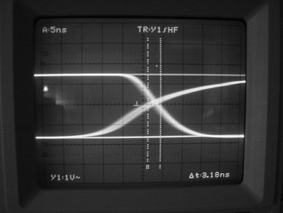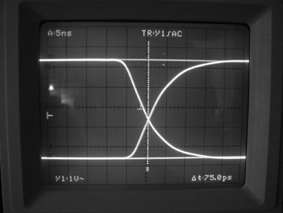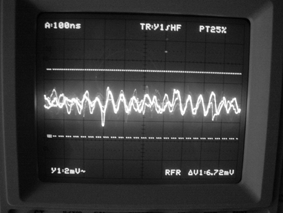How does jitter sound?"How sour, sweet music is if time is broke and proportion kept" Robert Watson and Richard Kulavik of Burr Brown (a semiconductor manufacturer) uses this Shakespeare citation in their digital audio design seminar in order to describe the audible effects of jitter. In this chapter, we will try to explore the sound of jitter. But before we talk about listening sessions let´s take a look at "jitter measured with instruments". Then we will explain the experiments that are necessary to know that we really audition jitter-effects and nothing else and then we try to relate our hearing results to the measurements. What can we measure?Let us first take a look at the signal itself. The following picture is a screenshot from an Oscilloscope. It shows a jittered transition of an S/PDIF signal that comes out of a TORX173 Toslink receiver (go to the datasheet.pdf) (often used in audio products). The transmitter is a low cost CD player. To make it worse, the Toslink cable for this shot was app. 10 meters long instead of the normally used 1 meter cable lenght.
The scope is operated in analog mode, what you see is a superimposition of multiple transitions. This looks quite unsharp because the transitions jitter. The time between the two vertical lines is displayed in the bottom right edge of the screen: the jitter amplitude seems to be about 3 nanoseconds. But how looks a signal with less jitter? The next scopeshot shows the same signal after having been reconditioned with an Altmann Ultra-Precicion-Clock Injector (UPCI):
The superimposition of these transitions looks nice. We have residual jitter in the range of picoseconds. The shape of the signal is much better. We have the original amplitude of 5 Volt and faster rise and fall times. If you are able to feed a signal of this quality into your converter, you are a lucky guy. The above scopeshots give you a basic view of a "signal with jitter". We may see if there is more or less jitter, but thats it. If we want to see the jitter itself, without the signal, we can input our signal into a phase locked loop and measure the control signal of the voltage controlled oscillator. This kind of measurement interprets jitter as a frequency modulation. What we see on the scope is not the signal that carries the jitter, but the jitter inside the signal as a deviation-waveform from the center frequency.
This measurement is in so far uncomplete as the results depend heavily on the phase-comparator and loop-filter used in the PLL. Furthermore the deviation waveform on the scope represents more the jitter at the output of the PLL than the jitter of the original input signal. However, if we take this signal and feed it into a spectrum analyzer, we will get a more detailed idea of the frequency components of the jitter. A more audio-related approach is to feed a "jitter-free" sinewave (as a digital input) into an DA converter and analyze the spectrum of the analog output. What you get can be called the overtone spectrum of the converter device. The second step is to feed the same signal with jitter into the DA converter and analyze the spectrum of the analog output with respect to the "jitter-free" spectrum. What happens? Watson and Kulavik state "Clock jitter causes the width of the fundamental frequency to spread. Additionally the jitter frequency, whether random or distributed, increases the value of the noise floor. Hence SNR and THD+N are both degraded." (go to the article.pdf page 24ff.) Related measurements by Julian Dunn (of Nanophon) culminated in his statement: Quantitative jitter measurement is complex and expensive, since sophisticated instruments are needed. GuideTech makes time scopes with resolutions down to 1 picosecond. LeCroy makes digital oscilloscope capable of basic jitter measurements. Amherst has jitter analysis tools for real-time scopes. The Experiment SetupWell, if you want to know the sound of jitter, you have to compare it with "no jitter". Since absolutely no jitter is not possible lets say we compare it with very much less jitter. The transmitter of our jitter experiment is a Philips CD723(go to the Philips website) CD player which costs about US$99 (same in Euro). We were confident, that this product would deliver large amounts of jitter. The CD723 has a coaxial S/PDIF output only but we added an optical TOSLINK output in order to be able to compare the two interfaces. The CD723 features a low cost transport solution from Philips that is called shortloader module or ECO-SL(go to the datasheet.pdf). It is able to read CD-Rs and CD-RWs. The digital output of the CD723 was connected to an Altmann superlative 24bit / 96khz digital to analog converter (go to the datasheet.pdf), which features very high quality audio reproduction. The above DA converter features a CS8414 (go to the datasheet.pdf) 96kHz digital audio receiver from Crystal (a semiconductor manufacturer) which is a standard in digital audio equipment. The CS8414 has an internal PLL that locks to any sampling frequency from 32kHz to more than 100kHz. This internal PLL is able to attenuate higher frequency jitter to a certain extent (see the datasheet). No further jitter attenuation is done inside the Altmann DA. With this setup we are able to emulate jitter effects that happen in app. 90% of all installed hifi- to high-end systems. This was the setup for hearing jitter. For hearing no jitter or very much less jitter we added an Altmann-UPCI (Ultra Precision Clock Injector go to the datasheet.pdf) that is connected between the digital transmission line from the digital source (f.e. CD player) and the DA converter and strongly attenuates the jitter. In order to be sure that we hear jitter effects and not reading errors or interpolations from the CD player we had to monitor the correction flag (cflg) output of the CD-player's decoder chip SAA7376 (go to the datasheet.pdf). This was accomplished by an external microcontroller that was programmed to increment the number on a 4 digit display on every interpolation or hold. With this tool we had the accurate count of all uncorrected samples that were output during the track or the entire CD. The funny thing is, that the low cost CD723 player is able to read any CD or CD-R that is not severely scratched without any interpolation or hold. You can even put it upside down, there will be zero interpolation /hold. Uncorrected samples could only be generated by dropping the player (5cm) or by extremely scratched CDs. This gave us the confidence that our experiment setup is valid, and we knew that the jitter phenomenon really deserves our full attention. Since it is commonly believed, that audible differences between
are due to reading errors, or different capabilities of the transport to extract the original audio data, we can now be sure, that this is not the case. The reading of the CD is performed immaculately even by todays cheapest players (or at least by the cheapest Philips CD players). Audible differences in these cases are generated by jitter. Additional tests were done with a Pioneer DV-505 DVD player and Chesky 24bit / 96kHz recordings. Welcome to Subjectivity"All of you had to descend into the world of the senses to draw from it the powers required for a higher world", says Rudolf Steiner in his book: "How to know higher words". Okay, what comes now is strictly subjective, since the personal perceptions of the people that had the opportunity to audition our experiments. Anybody can come up an state that it is true or untrue, we cannot care. Among the listeners were friends / colleges that came by chance and audiophiles with hearing experience. The tests were always jitter vs. less-jitter or in other words Altmann-UPCI not installed or installed. We tested with CD (16 bit, 44,1kHz) and DVD (24bit, 96kHz) recordings. Here the results: 1) It makes a big difference. Everybody (with intact ears) can hear it. Once heared, one can differentiate within the very first second if the reproduction is jittered or not. It is a totally different sound quality. 2) "Less jitter" sounds better, much better!
Auditioners testified: At this point i would like to refer to the measurements. If i would urge you to look at the jittered transition (first scopeshot above) and tell me where the exact transition is, you would say to me: "Are you crazy? The picture is entirely unsharp and it is impossible to say where this damn transition exactly is." But if you were forced to find out the exact position and you had to use your full concentration, this would surely be a tiring and useless experiment? Now you know what request from your ear and associated post-processing, if you hear a jittered sound source: Your ear tries to extract the exact sound and frequency, but it cannot succeed, but it tries to, but it cannot succed, but it tries... If you then remove (lessen) the jitter something happens that is best described in Ennemoser's book "The Character of Sound": "If the brain, however, receives sound patterns of C37 or similar quality, it has little processing to do and rewards the owner with positive images such as: saturated, full, warm, melting brilliant ..." If you remove or lessen the jitter to a certain extent, your ear & brain will be relieved from a straining task. A measurement result of Watson and Kulavik is: "What happens is that the width of a given fundamental will increase in the presence of word-clock jitter. In a jitter free environment a fundamental frequency tone would show up on a spectrum analyzer as an impulse. As jitter is introduced this impulse begins to spread". This is exactly what you will hear: An instrument's or a singer's voice will spread out. You are not able to define the sound and you have the impression that the single tone is dirty or unclear. If you concentrate on a single tone, it will be as if the tone is rejected by the ear. Just like some kind of recoil. You may identify the frequency of the tone but you are not able to hear whats inside the tone. Then remove the jitter and the same tone becomes extremely defined, clear and airy. You will hear a wealth of details that was covered before. It is like the human capability to hear a voice and be able to tell something about how the singer feels. This information or impression lies inside the voice and if you hear any tone, your perception will try to extract all this information. This information / quality is supplied within a low jitter audio reproduction and can be extracted by the ear very effortlessly. 3) It is an entire new experience to hear a CD with less jitter. The change in quality is such drastic, that even audiophiles stated, they did not expect to ever get this quality from a CD recording. 4) The same applies for DVD recordings. Although a DVD 24bit 96kHz recording can give a good sound it will be drastically improved with less jitter. |
|||||
|
|
|||||
| .
Text and scope shots (c) by Charles Altmann |
|||||


